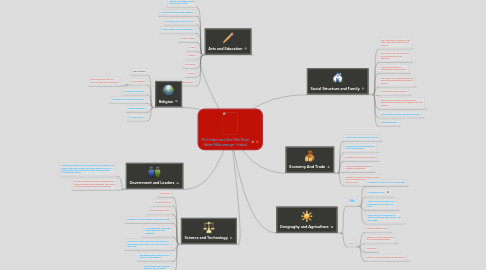The Indus and the Nile River (blue-Nile orange- Indus)
by Lauren Suda


1. Government and Leaders
1.1. Eygpts government took place during the old kingdom, the leader in this was a King and ruled by religious leaders. To protect these leaders there was a well established wall surrounded by guards.
1.2. By the Indus there was central authority that planned/lead the cities uniformly. The central authority had power over the civilization.
2. Arts and Education
2.1. Egyption paintings are both detailed and colorful.
2.2. Few children often had an eduaction
2.3. Egyptions were prolific writers
2.4. Used a system called hieroglyphics
2.5. Writing system
2.6. Crafts
2.7. Pottery
2.8. Metal work
2.9. Jewlery
2.10. Standard sets of weights and measurement
3. Religion
3.1. Vedic Religion
3.2. Vedic Religion
3.2.1. Became popular after the decline of the Indus civilization
3.3. Worshiped many gods
3.4. Built temples to worship their gods
3.5. Believe in afterlife
3.6. Buried in tombs
4. Science and Technology
4.1. Water Wells
4.2. Grid pattern cities
4.3. Public drainage system
4.4. Egyptions were interested in Science and Math
4.5. In math they had a thorough understanding of basic arithmetic
4.6. Instead of trying to understand how the world worked they used science and math to improve their lives
4.7. Building pyramids requires a firm grasp of understanding
4.8. Greatest Egyptian's scientific advances were medicine
5. Social Structure and Family
5.1. The community consisted of two large cities surrounded by small villages
5.2. Top of the social "pyramid" was the royal family and the weathiest.
5.3. Next level was artisians, craftspeople, and merchants.
5.4. The lowest layer which consisted of 90% of the people was the peasent farmers.
5.5. Marriage depends on classses
5.6. Fathers were the head of the household, women worked outside of the house and raised children
5.7. The head was King and eventually pharaohs
5.8. It was a theocracy
6. Economy And Trade
6.1. Trade routes into Egypt weren't safe.
6.2. Egyptions from Middle Kingdom traded with Nubians
6.3. Focused on agriculture and trade
6.4. Traded with both near by and distance communities
6.5. Distant communities included Central Asia, the Arabian Pennsula, and Mesopotamia
7. Geograghy and Agriculture
7.1. Nile
7.1.1. Longest river in Africa. (4,000 miles long)
7.1.2. Flooded every year
7.1.3. Richest and most fertile soils in Egypt were found in the Nile Delta.
7.1.4. Dark color of the river gave the Egytion's name for their country "The Black Land"
7.2. Indus
7.2.1. Flooded northern plains
7.2.2. Flowed across northwest edge of the subcontient in India
7.2.3. Very fertile
7.2.4. Monsoon rains determine crops and famine
